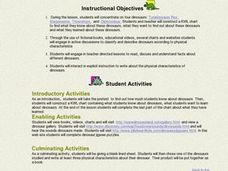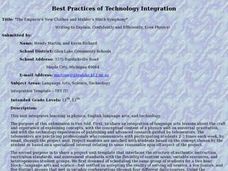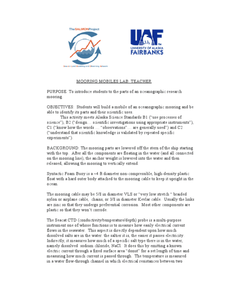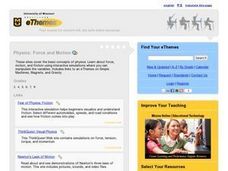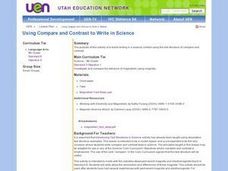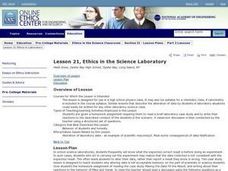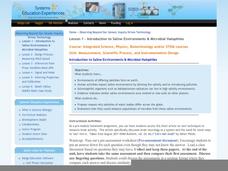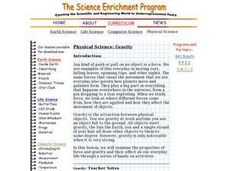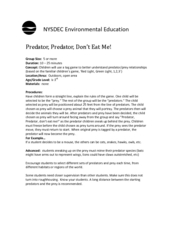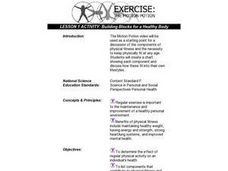Curated OER
Dinosaurs - Physical Characteristics
Students describe the physical characteristics of dinosaurs, compare and contrast the evolution of land, and they explore the extinction of dinosaurs.
Curated OER
The Letter Rr: Alphabet Theme
Young scholars complete several cross-curricular activities to learn the letter Rr. In this letter recognition lesson, students complete activities that include geography, music, physical education, science, seasonal, space science, and...
Curated OER
Angular Momentum (Automaticity)
Second graders experience practicing with a wide variety of vocabulary terms that relate to the Vista/Module "Angular Momentum:" momentum, inertia, force; motion, direction, centripetal force; angular momentum, gyroscope, resist. They...
Curated OER
"The Emperor's New Clothes and Mahler's Ninth Symphony" Writing to Explain, Confidently and Efficiently, Even Physics!
Students combine their study of physics with their study of best practices when writing to inform. They communicate with experts using e-mail before creating a brochure based on their study of universal gravitation.
Curated OER
Mooring Mobiles Lab
Oceanography experts use candy to construct a model of a bio-physical mooring that would test a variety of factors. Each piece of equipment to be included on the mooring is described within the write-up. As pupils gather the candies for...
APlusPhysics
Generate an Argument: Indian Point Nuclear Plant
Small groups in your physics class collaborate on researching and forming an opinion on whether or not to continue operating the Indian Point nuclear power plant in New York. Once the information is gathered and an argument developed,...
Curated OER
Physics: Force and Motion
Students use the internet to discover the basic concepts in physics. They complete interactive simulations where variables can be changed. They answer comprehension questions to end the lesson.
Curated OER
Using Compare and Contrast to Write in Science
Fifth graders investigate and compare the behavior of magnetism using magnets. In this physics lesson, 5th graders write about the similarities and differences of a variety of magnet types.
Curated OER
Physics: Water-Bottle Rockets
Students research how physics laws create motion and propel rockets. They examine how to build water-bottle rockets.
Curated OER
Ethics in the Science Laboratory
Students consider the role of ethics in science lab procedures. In this ethics instructional activity, students explore a scenario that requires them to record their reactions to the case and the conduct of students in the case who alter...
Institute for Systems Biology
Introduction to Saline Environments & Microbial Halophiles
If you do not mind wading through unrelated headings (This is not for a physics or STEM course, as it states.) and content (The activity opens with an article about neurology, not halophiles.), then you will find a valuable resource on...
Curated OER
Boot Reer Root Beer
Fifth graders investigate chemical reactions. In this physical science instructional activity, 5th graders make dry ice root beer and identify the type of change that occurs to the root beer mixture.
Curated OER
Freshwater Sharks Bite Children at 35th Beach. A Play
Students delve into a study of sharks. In this science lesson plan, students examine the many different scientific occupations, as well as some possible specializations therein, and perhaps a little bit of other life considerations,...
Curated OER
Physical Science: Gravity
Students investigate the properties of force and gravity and their effects on everyday life. In groups, they test various balls by bouncing them on different surfaces and observe the properties. In another activity, they test marbles and...
Curated OER
Global Warming and Hurricanes: Is an Increase in the Number of Stronger Hurricanes an Indicator of Global Warming
Ninth graders investigate whether stronger hurricanes are signs of global warming. In this environmental science lesson, 9th graders research both sides of the issue about global warming. They debate for or against this issue in class.
Curated OER
Science- Unit on Matter- Solids
Second graders identify and describe properties of matter.
They identify three forms of matter- solids, liquids, and gases with 100% accuracy. The student describes the properties of solid objects.
Curated OER
Science: Solids
Second graders investigate the properties of solids and discover how to classify them. Using rulers, they measure various solids on display. In groups, they play an identification game where one students names a location, such as the...
Curated OER
Science- Unit on Matter- Liquids-
Second graders discover that everything is made of matter. they determine the properties of liquids and that like solids, liquids can be grouped or classified according to properties or qualities. they assess that solids have a definite...
Curated OER
Science: Changes in Matter
Second graders discover what changes occur in various types of matter under different conditions. They make predictions about the changes in an apple left out in the air, water placed in a freezer, and a nail left in a cup of water. They...
Curated OER
Science: Floating and Sinking Objects
Second graders discuss why some objects float while others sink. They examine various objects and predict whether or not they will sink or float. Students discover the properties needed for objects to float.
Curated OER
Predator, Predator, Don't East Me!
To prep for a lesson on predator/prey relationships, get kids up and moving. This game is based on the game 'Red Light, Green Light' but employs the concept of predator vs. prey. This is not a full lesson but could be useful as an...
Curated OER
Building Blocks for a Healthy Body
Pupils watch a video and discuss the benefits of regular exercise. They use books, Internet sites and interviews with health professionals to develop a list of activities to develop physical fitness.
Curated OER
The Letter Ff: Alphabet Theme
Students complete several cross-curricular activities to learn the letter Ff. In this letter recognition lesson, students complete activities that include geography, music, physical education, science, seasonal, space science, and online...
Laboratory for Atmospheric and Space Physics
Jupiter’s Relative Size
How do you properly illustrate the extreme size difference between two planets—Earth and Jupiter? With the help of jellybeans, of course! Create a scale model of Jupiter's mass compared to Earth using a fishbowl, 1,400 beans, and a...


